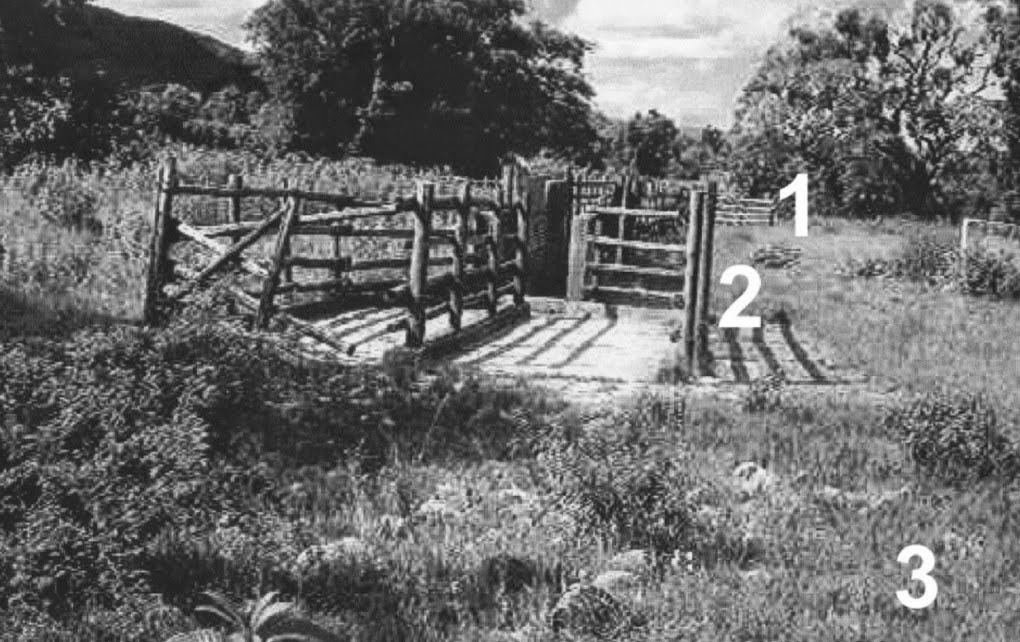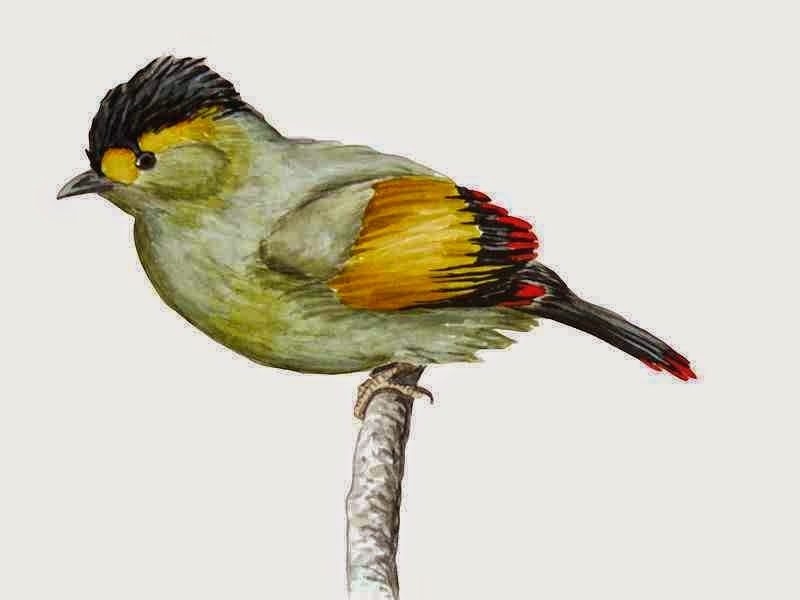In the late 1990s and early 2000s it became apparent that the
Oriental White-backed Vulture, Gyps
bengalensis, Long-billed Vulture, Gyps
indicus, and Slender-billed Vulture, Gyps
tenuirostris, were undergoing rapid population declines across Bangladesh,
India, Nepal and Pakistan, loosing roughly 30-40% of their population each
year. This was eventually found to have been caused by widespread use of the
non-steroidal anti-inflammatory drug Diclofenac as a veterinary medicine for
Cattle, the main food source of these Vultures across much of their range.
Diclofenac and related drugs were found to be highly toxic to the Vultures,
with mass death events occurring due to incidental poisoning.
This population decline was so severe that all three species were
classed as Critically Endangered under the terms of the International Union Forthe Conservation of Nature’s Red List of Threatened Species (there are only two
higher categories, ‘Extinct in the Wild’ and ‘Extinct’), and many Birds were
taken from the wild for use in a captive breeding program, to prevent the
Vultures from becoming completely extinct (conservationists are generally
extremely reluctant to do this as it is expensive, time consuming, and there is
a very high mortality rate – typically 40-60% - among captive bred birds
released in the wild).
Since this time the use of Diclofenac as a veterinary medicine has
been banned across all four countries, though it is known that medicine
officially designated for Human use is still widely used to treat Cattle, and
that in some areas it has been replaced with related drugs which are equally
toxic to Vultures, and populations in some areas have stabilized enough that
Saving Asia’s Vultures from Extinction, an umbrella group of governmental and
non-governmental agencies involved in conservation across South Asia, is
beginning the first steps of a re-introduction programme for the Vultures.
In a paper published in the July-September 2014 edition of the
journal Mistnet, Ananya Mukherjee and Toby Galligan of the Royal Society forthe Protection of Birds, Vibhu Prakash of the Bombay Natural History Society, Khadananda Paudel
of Bird Conservation Nepal, Uzma Khan of WWF Pakistan, Satya
Prakash of the Neo Human Foundation, Sachin Ranade, Kartik Shastri and Ruchi
Dave, also of the Bombay Natural History Society and Paul Donald and Chris
Bowden, also of the Royal Society for the Protection of Birds, discuss the
creation of Vulture Safe Zones for the re-introduction of Gyps Vultures across South Asia.
The Critically Endangered White-backed Vulture, Gyps bengalensis. Dhritiman Mukherjee/Misnet/Bombay
Natural History Society.
While ideally it would be desirable to fully eliminate the use of
Diclofenac and similar non-steroidal anti-inflammatory drugs across South Asia,
making the entire region once more a safe environment for the Vultures, nobody
believes that this is a reasonable prospect in the near future. Instead the
Vulture Safe Zone concept, which was developed by Bird Conservation Nepal and
which is now being spread to Bangladesh, India and Pakistan, seeks to create a
network of safe areas across the countries where populations can recover and
re-introductions occur, with the long-term aim of re-establishing the Birds
across their full range.
Mukherjee et al. recommend
the initial creation of provisional Vulture Safe Zones centred on surviving
breeding colonies of Vultures. Due to the far-ranging foraging activities of
the Birds, such a provisional Safe Zone should have a radius of at least 100
km. This means it will cover over 30 000 km2 of land, an area likely
to include hundreds of communities, millions of potential Diclofenac-using
livestock owners, tens of millions of Cattle and may also cross state and
national borders.
Once such an area has been identified, it is necessary to establish
a team of field biologists and advocacy officers, capable of monitoring
drug-use in Cattle and the health of Vultures, as well as communicating the
aims of the project and hazards of Diclofenac use to local communities and
decision makers.
Awareness workshop at Forest Department, DudhwaNational Park in Uttar Pradesh. Ananya Mukherjee/Misnet/Bombay Natural History Society.
The most important process in the establishment of a Vulture Safe
Zone is the advocacy of Diclofenac-awareness to pharmacists, veterinarians,
paravets (unqualified animal-healthcare practitioners) and livestock owners
within the provisional Safe Zone. Such a process would typically start with
meetings with government officials responsible for forest and environmental
management, drug control and animal husbandry, which would then be followed up
by meetings with grassroots organisations such as dairy cooperatives and
community groups. It is particularly important to identify and reach networks
of untrained veterinary workers (paravets) working within Cattle-herding
communities.
Within the provisional Vulture Safe Zone the Vulture population
should be subject to regular surveying, particularly of breeding success. Where
possible subsidised alternatives to Diclofenac and similar non-steroidal
anti-inflammatory drugs, such as Meloxicam, can be distributed; in Nepal local
NGOs carried out a variety of awareness raising projects, such as ritually
burning supplies of Diclofenac. Local pharmaceutical companies should also be
contacted and reminded of their responsibilities, particularly the legal
implications of killing highly protected Birds.
Distribution of subsidized Meloxicam in Jharkhand. Satya
Prakash/Misnet/Bombay Natural History Society.
Within a provisional Vulture Safe Zone it is recommended that the
safety of the Vultures be monitored in three ways.
Firstly local pharmacies should be monitored for Diclofenac and
similar non-steroidal anti-inflammatory drugs. Diclofenac is not actually
illegal for Human consumption, though it is for use in livestock, creating a
problem of supplies which are officially for Humans but used in Cattle. However
vials genuinely intended for Human use contain doses in the 2-5 ml range, while
those for Cattle are typically 30-50 ml (i.e. 10 times as large), making
monitoring supplies for intended use possible. Where Diclofenac is being sold
for livestock use it is recommended that advocacy work be stepped up. Where it
has apparently disappeared it is still important to carry out regular surveys.
Once obvious supplies of veterinary Diclofenac have disappeared from
local pharmacies it is possible to begin monitoring Cattle and other domestic
Ungulate carcasses for the presence of the drug (doing this before the supplies
have been eliminated tends to be a waste of resources). Ideally around 800
carcasses should be monitored over a two year period within each provisional
Vulture Safe Zone, though in practice finding this many carcasses can be a
challenge.
Vulture carcasses can also be monitored for the presence of
Diclofenac, but these can be even harder to locate. Instead Saving Asia’s
Vultures from Extinction are experimenting with satellite telemetry, attaching
radio transmitters to a small number of Vultures (monitoring the whole
population in this way would be impossible as the process is expensive and
requires specialist skills), in order to monitor their movements and locate the
carcasses quickly if they die.
Mukherjee et al. also note
that Vulture restaurants have been successfully combined with Vulture Safe
Zones in Nepal. Such restaurants provide safe feeding environments for the
Vultures at a single geographical point, which is of limited direct value since
Vultures are dying of poisoning rather than starvation across South Asia,
however these can be high-profile locations which attract the attention of
decision makers, communities, and donor organizations, thereby raising the
profile of Vulture conservation. At Vulture restaurants elderly Cattle are
bought from or donated by the local community and looked after till they die of
natural causes. While they are being cared for alternatives to Diclofenac and
similar non-steroidal anti-inflammatory drugs are used if pain relief is
necessary. Since Diclofenac can remain in the bodies of Cattle for up to a
week, only Cattle which have been looked after at the restaurant for at least
ten days are used to feed the Vultures, other animals being buried to avoid
accidental poisoning. However while such sites are good at raising the profile
of Vulture conservation, they are expensive to run, and serious thought needs
to be given as to whether such funds could be used on other forms of advocacy.
Saving Asia’s Vultures from Extinction and associated groups are
currently working on the establishment of twelve Vulture Safe Zones at, Southern Sindh in Pakistan, Southern Gujarat,
Central Gujarat, Lowland Uttarakhand, Central Madhya Pradesh, North-eastern
Uttar Pradesh, Northern Jharkhand and Central Assam in India; Western Lowland
and Central Highland in Nepal and Southern and
Northern Bangladesh.
Vultures in aviary at a Conservation Breeding Centre. Chris
Bowden/RSPB//Misnet/Bombay Natural History Society.
See also…
 Arsenic levels in soil around cattle-dipping sites in the Vhembe District of Limpopo Province, South Africa. Arsenic-based cattle-dips were used in South Africa from their first
becoming available in1893 until their...
Arsenic levels in soil around cattle-dipping sites in the Vhembe District of Limpopo Province, South Africa. Arsenic-based cattle-dips were used in South Africa from their first
becoming available in1893 until their...
Birdlife International published an assessment of the conservation status of 350 newly described Bird Species for International Union for the Conservation of Nature's Red List of Threatened Species on 24 July 2014, the first such assessment by the organization...
The Old World Vultures are divided into two subfamilies, the Gypaetinae
and the Aegyptiinae, both of which belong to the Bird of Prey family,
Accipitridae, which also includes Eagles, Hawks and other Birds of Prey.
The New World Vultures and Condors are more distantly related, and
placed in a separate family, the Cathartidae, within the order
Accipitriformes, which also includes the Ospreys and Secretary Birds.
Both groups of Old World Vultures are currently restricted to Africa and
Eurasia, but are known in the fossil record of North America.
Follow Sciency Thoughts on Facebook.






